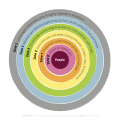Permaculture

Permaculture, is a combination of the words permanent and agriculture, offers a unique approach to the practice of sustainable farming, ranching, gardening and living.
Concept[edit]
Permaculture shows how to observe the dynamics of natural ecosystems. We can apply this knowledge in designing constructed ecosystems that serve the needs of human populations without degrading our natural environment.
Symbiotic relationship[edit]
Permaculture sites integrate plants, animals, landscapes, structures and humans into symbiotic systems where the products of one element serve the needs of another.
Minimum outside materials[edit]
Once established, a permaculture system can be maintained using a minimum of materials, energy and labor.
Recycling waste[edit]
By recycling "waste" resources back into the system, it also minimizes pollution. It serves human needs efficiently by incorporating useful, high-yielding species.
Redundancy in the system[edit]
A permaculture system is designed to be diverse, so that even when one element fails, the system has enough stability and resilience to thrive. This gives it greater potential than a conventional system for long term economic stability.
History[edit]
Permaculture was developed in Australia in the late 1970’s by Bill Mollison and David Holmgren. It has since grown into an international grassroots movement.
Science and tradition[edit]
Permaculture is a unique blending of traditional practices and scientific knowledge, of ageless wisdom and innovative ideas, of time-tested strategies and useful information from around the world. Demonstration sites span the globe.
Permaculture systems[edit]
Permaculture systems have been established on every scale, from farms to apartments, from ranches to suburbs, in cities, gardens, schools and communities. They are proving successful in every climate, including the tropics, deserts, mountains and shores.
| This article is a stub. You can help WikiMD by registering to expand it. |
| Permaculture | ||||||||||
|---|---|---|---|---|---|---|---|---|---|---|
|
| Sustainability | ||||||||||
|---|---|---|---|---|---|---|---|---|---|---|
|
| Environmental social science | ||||||
|---|---|---|---|---|---|---|
|
| Simple living | ||||||||||
|---|---|---|---|---|---|---|---|---|---|---|
|
| Horticulture and gardening | ||||||||||
|---|---|---|---|---|---|---|---|---|---|---|
|
Permaculture[edit]
-
Permaculture garden
-
Franklin Hiram King
-
Bill Mollison
-
Mycorrhizal network
-
Ladybug and aphids
-
Permaculture Zones
-
Sketch of Hugelkultur bed in cross section
-
Preparation of a lasagna bed
Ad. Transform your life with W8MD's Budget GLP-1 injections from $75


W8MD offers a medical weight loss program to lose weight in Philadelphia. Our physician-supervised medical weight loss provides:
- Weight loss injections in NYC (generic and brand names):
- Zepbound / Mounjaro, Wegovy / Ozempic, Saxenda
- Most insurances accepted or discounted self-pay rates. We will obtain insurance prior authorizations if needed.
- Generic GLP1 weight loss injections from $75 for the starting dose.
- Also offer prescription weight loss medications including Phentermine, Qsymia, Diethylpropion, Contrave etc.
NYC weight loss doctor appointmentsNYC weight loss doctor appointments
Start your NYC weight loss journey today at our NYC medical weight loss and Philadelphia medical weight loss clinics.
- Call 718-946-5500 to lose weight in NYC or for medical weight loss in Philadelphia 215-676-2334.
- Tags:NYC medical weight loss, Philadelphia lose weight Zepbound NYC, Budget GLP1 weight loss injections, Wegovy Philadelphia, Wegovy NYC, Philadelphia medical weight loss, Brookly weight loss and Wegovy NYC
|
WikiMD's Wellness Encyclopedia |
| Let Food Be Thy Medicine Medicine Thy Food - Hippocrates |
Medical Disclaimer: WikiMD is not a substitute for professional medical advice. The information on WikiMD is provided as an information resource only, may be incorrect, outdated or misleading, and is not to be used or relied on for any diagnostic or treatment purposes. Please consult your health care provider before making any healthcare decisions or for guidance about a specific medical condition. WikiMD expressly disclaims responsibility, and shall have no liability, for any damages, loss, injury, or liability whatsoever suffered as a result of your reliance on the information contained in this site. By visiting this site you agree to the foregoing terms and conditions, which may from time to time be changed or supplemented by WikiMD. If you do not agree to the foregoing terms and conditions, you should not enter or use this site. See full disclaimer.
Credits:Most images are courtesy of Wikimedia commons, and templates, categories Wikipedia, licensed under CC BY SA or similar.
Translate this page: - East Asian
中文,
日本,
한국어,
South Asian
हिन्दी,
தமிழ்,
తెలుగు,
Urdu,
ಕನ್ನಡ,
Southeast Asian
Indonesian,
Vietnamese,
Thai,
မြန်မာဘာသာ,
বাংলা
European
español,
Deutsch,
français,
Greek,
português do Brasil,
polski,
română,
русский,
Nederlands,
norsk,
svenska,
suomi,
Italian
Middle Eastern & African
عربى,
Turkish,
Persian,
Hebrew,
Afrikaans,
isiZulu,
Kiswahili,
Other
Bulgarian,
Hungarian,
Czech,
Swedish,
മലയാളം,
मराठी,
ਪੰਜਾਬੀ,
ગુજરાતી,
Portuguese,
Ukrainian







